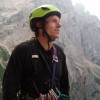‘I hope that employers value our ES graduates for their positive influence as well as their work’
Zoologist and biologist Carl Tobin says he’s been curious about science since he was a teenager. He spent undergraduate summers on glaciers, where he was a field technician on glaciology field projects in Alaska’s Wrangell and Aleutian mountain ranges. Traveling to Southeast Alaska and Greenland, Carl studied ice streams and surging glaciers. Occasionally he’d miss class, traveling for work by helicopter or research vessel far into the pack ice as an undergraduate technician at the Institute of Marine Science, University of Alaska Fairbanks.
Carl’s teaching interests include evolution and intelligent design, conservation biology, ecology, and botany, among others. He believes in structuring environmental science education at Alaska Pacific University so that students experience methods of scientific inquiry for themselves.
His research today focuses on wildlife management policy, examining testate amoeba as clues to past community structure and environmental conditions, as well as effects of development in wetlands.
Teaching in the Environmental Science Department at APU introduces you to students who might be pursuing a bachelor’s of science or arts degree or a minor or graduate degree in a wide range of areas. Is there a unifying interest?
What our students share is a dedication to produce work that attracts positive notice from people beyond our department itself.
For instance, when my winter ecology class and I traveled to Fairbanks for field observations, comments I heard complimented our students on their level of intelligence and interest. Our graduate students attract good notice too. It happened most recently when a master’s student presented her thesis on juvenile salmon distribution and movements in Potter Marsh near Anchorage.
Times like these – when our ES students produce finished products that garner attention for good work ethics and conceptual ability – that’s when I know APU is where I want to teach.
What’s different about Environmental Science at Alaska Pacific University and your college years?
I had wonderful mentors who always took time to answer my questions about science. I like to think that goes on today in our department as well.
What was missing was conversation about goals and career direction – questions that help shape a life in science and beyond. ES faculty and students have those conversations in academic advising and in informal classroom and hallway chats.
As chair of APU’s Environmental Science Department, what are your hopes for ES students? For the department itself?
Our department is good at tracking and responding to changes within our individual fields. Students benefit because they’re gaining knowledge, skills and experience that corresponds to change in the real world. I hope we continue adapting.
Among the distinctive features of the ES faculty is our level of cooperation. In the sciences, where advancements often are the product of teamwork, it’s important that students in our department continue to see collegiality in action.
I’d like to see an increase in the numbers of APU students enrolled in our degrees and programs, but I want to set reasonable limits on that growth as well.
When it comes to ES Department graduates, I hope they take satisfaction in ways that APU helped train them to meet challenges and set a satisfying direction in life.
After APU graduation, I hope our students stay in touch – many do. I hope that employers value our ES graduates for their positive influence as well as the good work they do.

